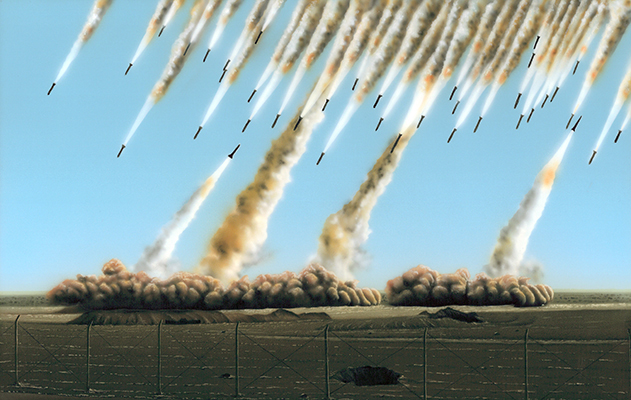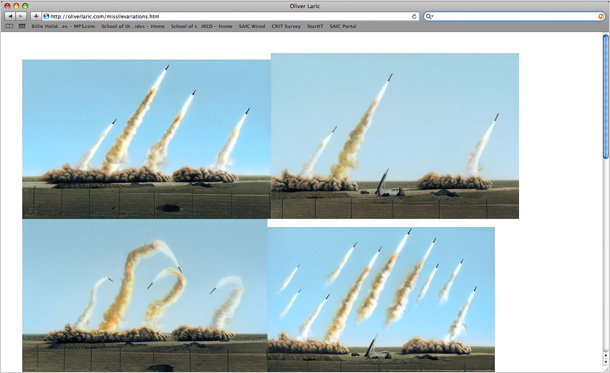![]()
New media in the 21st century is in a state. This is not merely to say that the thoroughly digitized landscape of communications technologies we are constantly immersed in is vast and disorderly. This additionally means that the disarray of hardware and the cultural matrixes it operates through, the semiotics of digital coding, and even content itself ultimately form a territory rather than a timeline. And this territory is exponentially expanding, driving new media further into a tragically postmodern situation and simultaneously engulfing contemporary new media art in the cyclical discourses found there.
Let us examine this state in more depth. At this point, any task or desire may be realized through a number of technological strategies with each user granted the ability to tailor a customized program of media for their specific requirements. On an accelerated basis, hardware itself is updated by its parent corporations to provide larger and faster flows of data, higher resolution, better reception. In essence, our laptops, cell phones, cameras, and other instruments are incessantly supplemented to reduce latency in the connection between the user and the omnipresent cloud.
The cultural conventions, or matrixes, that this hardware operates through are also prone to a movement of expansion. The collective experience once offered by broadcast-based communication has given way to what artist Seth Price has described as “simultaneous experiences… distributed across the field of media culture.”[1] In other words, media no longer operates by projecting singular units of content outwards to collectives of users but instead releases an abundance of personalized content to individual users.
Messages themselves have also been multiplied in this era of new media. Digital technologies imbibe any content with a potential for replication and dispersion ad infinitum. For instance, the digital object of an audio file can be archived with software, transacted to other users through file sharing services, copied onto the physical storages sites of optical media, posted and reposted on a number of blog based forums, and so on. As we move digital information from one site of readership to another, the translation of context becomes a form of production that creates multiple new meanings for a single original text.[2]
There is something inherently postmodern to all of this. The philosopher Jean-François Lyotard suggested that the postmodern epoch could be identified in part by an epistemological alienation, one in which the subject is distanced from knowledge by the very process of learning or receiving information. This alienation was considered to correspond with the collapse of totalizing communicative forces, or what Lyotard understood as the grand narrative.[3] Without the universal comprehension offered by such narratives, the very idea of truth falls under the shadows of skepticism and apathy, cornerstones of a postmodern perspective. New media, as it has been thus observed, endlessly performs this condition of postmodernity. A user within contemporary media systems is positioned by those very systems onto an unstable intersection of technological, linguistic, and communicative protocol. Once in this position, the user is left with no orthodox strategy, without a grand narrative, for comprehending the digital labyrinth that surrounds them.

A great deal of new media art is still in lockstep with this condition; artists have been prone to proliferate the postmodern status quo of new media itself. We can see such forces of cultural philosophy and technology at ease with one another in the artist Oliver Laric’s piece Missile Variations (2010). This particular work consists of several images, all of them alterations of a photograph from 2008 that supposedly documented a successful test of medium range ballistic missiles by the Iranian military. This photo was of course later revealed by the French news media as having been digitally manipulated. While Laric’s series exists physically as airbrushed sheets of Dibond, the images also embody a virtual existence as a rather anonymous page on the artist’s website and as components in a video series known simply as Versions.
Indeed, the artist has spoken of his practice as an engagement with “versioning”, a process he has conceived that explores and even celebrates the corrosion of hierarchies favoring un-manipulated, original, or what we might consider truthful content.[4] Missile Variations, then, stands as an artistic embodiment of the postmodern collapse of the grand narrative par excellence. But as we have already seen, it is in the very nature of new media to shape such a collapse. A question we might then ask, as culture at large shifts into an era of metamodernism, is how might new media art progress beyond the postmodern circumstances so deeply embedded in new media itself. A critical approach to time and history is but one area in which we may find a potential solution to this conundrum.
The postmodern condition philosophically described by Lyotard, put into praxis as new media, and aesthetically honored by Laric can also be interpreted as a form of historical thinking. Time in postmodernism is spatialized by the abandonment of modernism’s penchant for linear history. While modernity used a clearly defined idea of the past to inform the present in order to shape the future, postmodernism tends to accumulate all events into an ever-expanding present, turning time’s arrow into an achronological network of occurrences.[5] At this end of history as it has been called, there is no cause to delineate something’s origin and no effect to logically mark its development or conclusion. With this, the last nail is hammered into the coffin of modernism’s grand narrative of progress. This form of anti-history is certainly at play in Laric’s Missile Variations as well. The missile test image the artist remixes already lacks a solid origin rooted in reality and this unstable ground is only disrupted further by Laric’s aesthetic interventions. The means the artist uses to enact this versioning are also indicative of postmodernism’s spatial and ahistorical perspective on time: with all facets of new media constantly expanding and multiplying, the idea of an origin to any machine, language, or message becomes uncertain.

At least with media, however, this accordance with the end of history may not have always been the case. The media theorist Marshall McLuhan once famously stated that “the medium is the message” or more specifically that “the content of any medium is another medium.”[6] For instance, the medium of cinema is theater, which is the medium of the playwright’s script, which is the medium of the written word, which is the medium of the spoken word, and so on. McLuhan’s observation of media insinuates that any given medium is one permutation of a larger genealogy or a linear trajectory of that medium developing through time. Of course, this was written in 1964, a time when media consumption for the average user would have included television, cinema, radio, vinyl records, and printed matter from books to newspapers. In other words, media with distinct semiotic codes that are more resistant to the movements of mutation and expansion that have come with the development of digital technologies. While the historical passages of such media have been antiquated and made suspect by postmodernism, a metamodern approach to understanding history through new media art oscillates between modernism’s linear arrow of time and postmodernism’s end of history.
To bring into practice such a metamodern approach to history via new media art, we must first realize that the postmodern space of contemporary digital communications does not erase so much as it obscures linear history by mapping it onto and within other temporal trajectories. The media genealogies McLuhan described have not simply vanished and, as such, may still be excavated and exposed from the depths of the new media rhizome. These excavations attain an elemental quality of metamodernism in that they parse a linear history indicative of modernism from that achronological network indicative of postmodernism.
Coincidentally, this metamodern process can also be observed in Oliver Laric’s practice, specifically in the series Icon (Worcester) (2009). As suggested by the title, the subject matter of this body of sculptural work is a religiously charged stone relief from the English city of Worcester. Laric’s initial gesture is to use tourist photographs as source material to recreate the relief as a 3D digital rendering. This virtual model is then used to 3D print a mold from which polyurethane facsimiles are cast. Just as in Missile Variations, we see here the extended translation and manipulation of a single image. But while the former piece revels in the collapse of linear history, Icon (Worcester) stands as a revival of that very model of time by presenting a consolidated history of sculptural materiality. The work begins with carved stone, moves to the virtual renderings of space made possible with digital technology, and finally settles in a sculptural object reminiscent in color and material of the 20th century’s innovation in polymer-based plastics.[7] One image is still fragmented by its translation across media but these translations can be arranged into a genealogy of the three dimensional medium.
![]()
The true oscillation of this metamodern mode of history comes from the instability of the linear narratives pulled from the rhizome of contemporary media. The philosophers Gilles Deleuze and Félix Guattari described that a key principle of the rhizomatic space is its resistance to rupture: “a rhizome may be broken, shattered at a given spot, but it will start up again on one of its old lines, or on new lines.”[8] While certain gestures and practices in new media art may be on the forefront of reviving the grand narrative of progressive history, this revitalization is prone to collapse as new media itself continues to expand. Long-term oscillation then comes when new media artists use their practice to present a linear history, scrutinize its disintegration under the motions of new media, and subsequently devise new works that further speculate on their initial investment in modernism’s grand narrative of time.
In a larger sense, we see that it is not impossible for new media and the art that utilizes it to escape the postmodern quality of today’s digital communications landscape and emerge into the coming epoch of metamodernism. Certainly elsewhere in the broad spectrum of culture, this ideological transition has already been facilitated and even prompted by technological innovation. For instance, new media is playing a crucial role in contemporary political activism. Social networking sites such as Twitter and Facebook, as well as search engines like Google, have been employed in the ongoing efforts of the Arab Spring as well as more recently in the large-scale protests in Turkey and Brazil. Here we see the populace of a nation also using new media to reactivate the modernist grand narratives of time and progress. The end of history’s infinite present is divided into distinguishable narratives of past, present, and future; narratives that offer hope and in many cases tangible results in terms of sociopolitical change.
While new media is still deeply entangled with postmodern ideology, we can also see that a movement beyond those embedded discourses is not unattainable. Even in its most postmodern state, the very design of new media can still effectively produce a condition of metamodernism. And this condition is only enhanced when artists and other cultural producers critically reflect on the myriad of new possibilities a metamodern media culture has to offer.
